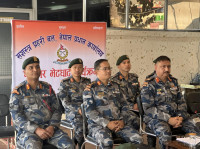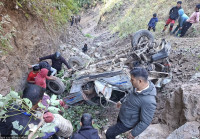National
TV screens to go blank next week as cable operators protest government’s clean feed policy
The situation has unfolded in the wake of announcements by cable operators that they will not broadcast any foreign pay channels that run advertisements for a whole day
Prahlad Rijal
On June 24, Nepali viewers switching their television sets are likely to find that 90 percent of the channels they have are not broadcasting anything else but a request to contact their cable operators. Or even, just a dark set with channel numbers.
The situation has unfolded in the wake of announcements by cable operators that they will not broadcast any foreign pay channels that run advertisements for a whole day starting June 24, 12:00 am. It means there will be no sports, daily soaps, movies or cartoons in the sets.
“That is what implementing the clean feed rule included in the proposed Advertisement (Regulation) Bill would look like, if enforced,” said Sudhir Parajuli, president of the federation of cable TV association of Nepal.
If indications are anything to go by, the bill tabled by Information and Communication Minister Gokul Prasad Baskota in January is likely to be endorsed by the Lower House in favor of the clean feed rule.
This means, the foreign channels must relay television contents in Nepal without advertisements from the date of implementation of the rule, as announced by the government.
This is not the first time the country has seen governments trying to implement clean feed rule asserting that the empty slots in foreign television content can be given to domestic advertisers.
“However, the authorities have not done proper research on how the rule can backfire,” said Parajuli. “The viewers will start subscribing to foreign channels through set-up boxes and viewing cards of Indian DTH operators, which are easily available in Kathmandu.”
Once that happens, the fate of Nepali channels, advertisers and even cable operators will hang in uncertainty caused by the loss of customers and, ultimately, revenue.
Also, acquiring the clean feed means Indian broadcasters who feed most of the foreign channels to Nepal must streamline the contents to make sure they run without adverts.
That requires them to set up a separate company dedicated to serving Nepal, a country which generates ‘very low average revenue per user’, at increased costs.
As a result, the Nepali service providers will also be subjected to higher downlink (subscription or broadcasting) costs, which they say, is not economically feasible.
Also, if the foreign channels stop beaming their signals to televisions in Nepal, the government will lose revenue from annual license fees it takes from all the channels, which are watched widely by the Nepali population.
In 2017, attempts to implement the same clean feed rule under National Broadcasting Policy were thwarted by criticisms from Nepali service providers and Indian stakeholders who used the diplomatic route to relay their objections.
Following criticism, the government, which had announced in the budget for the fiscal year 2017-18 to implement clean feed, backtracked on its decision citing a lack of preparations.
And cable TV operators say the situation, by and large, remains the same and implementing clean feeds would foster pirated contents, and shutdown of Nepali channels. Ultimately, cable operators would be thrown out of business.




 8.12°C Kathmandu
8.12°C Kathmandu















